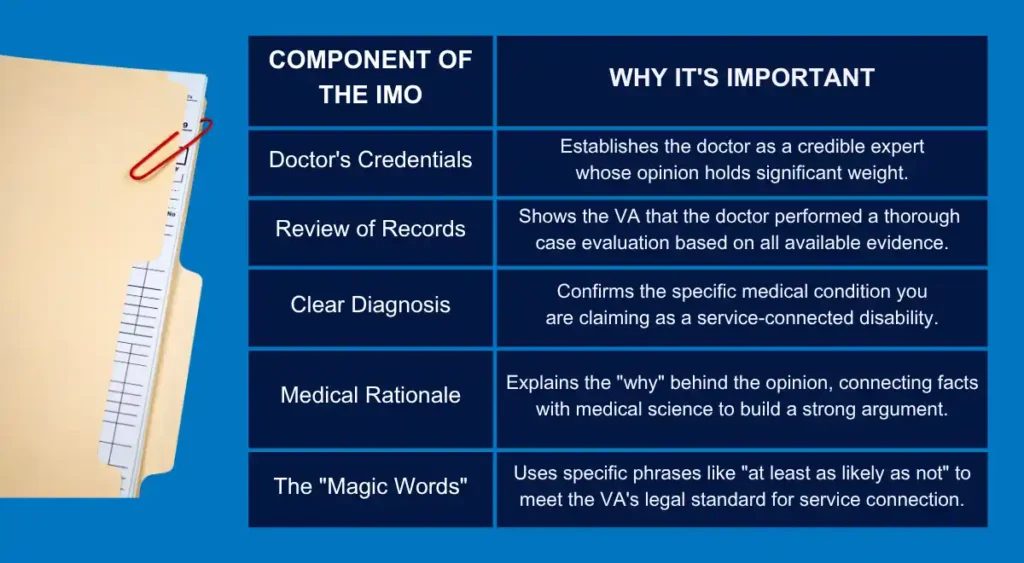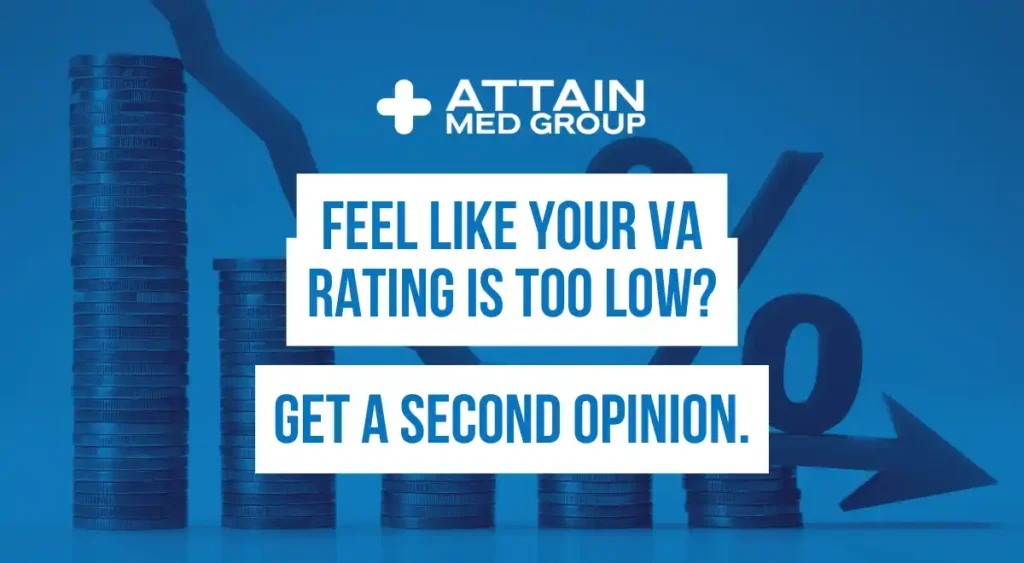You’re staring at that letter from the VA. The percentage feels like a slap in the face. All those appointments, all that paperwork, and this is what you get? If you feel like your VA rating is too low, you aren’t alone and you certainly aren’t wrong for feeling that way. It’s a common story, and it’s beyond frustrating.

You served your country. You carry the physical and mental scars from that service every single day. The disability rating you receive should reflect the reality of your life now, not just what a single overworked examiner decided during a brief appointment.
But there’s a way to fight back, a path to get the rating you actually deserve. A proper medical second opinion could change everything. It’s a critical tool for getting a disability rating increase and the VA benefits you have earned.
Why Your Initial VA Rating Might Be Off
It’s easy to feel defeated when your rating comes in low. You might think the system is rigged or that nobody believes you. The truth is often more about a complicated process than any ill will from the Department of Veterans Affairs.
Your Compensation and Pension (C&P) exam is the cornerstone of your disability claim. Unfortunately, the examiner is only human. They might be having a bad day, they may not specialize in your specific condition, or they might just be rushing through a long list of appointments at the VA regional office.
Sometimes, the examiner simply doesn’t connect your current disability back to your time in service. This crucial link, known as a “nexus” or service connection, is everything in a VA disability claim. Without that clear connection, your original claim can be denied or rated at a lower percentage than it should be, affecting your monthly compensation.
The VA examiner’s opinion is just one piece of evidence, but it carries significant weight. A negative or lukewarm C&P exam can stop a deserving claim in its tracks. This is a primary reason why many veterans are left with a lower disability rating than their service-connected disability warrants.
The Power of a Fresh Set of Eyes
A medical second opinion from a private doctor is your chance to add a powerful new voice to your claim. This is not just about getting someone to agree with you. It’s about getting a detailed, well-reasoned medical opinion from an expert who has actually taken the time to review your case file and medical history.
This document is often called an Independent Medical Opinion (IMO) or a nexus letter. A strong IMO can be the single most important piece of new and relevant evidence you can submit. It directly challenges the original C&P exam findings with credible medical reasoning, helping veterans get the rating they deserve.
Think of it this way: the VA has its doctor’s opinion. Now, you’re providing yours from your chosen health care provider. When a new reviewer or a senior VA rater at the regional office looks at your file, they have to weigh both pieces of evidence, which can absolutely tip the scales in your favor for a rating increase.
Feel like your VA rating is too low? Here’s how to get a medical second opinion that could change everything.
Getting a powerful second opinion is not as simple as just visiting any doctor. You need a strategic approach to get a medical report that the VA will take seriously. You cannot just walk into an urgent care clinic and expect a game-changing report that leads to a higher disability rating.

Step 1: Find the Right Kind of Doctor
The most important step is selecting the right medical professional. You need a doctor who not only understands your condition but is also familiar with the specific language the VA uses. The best choice is a specialist in the area of your service-connected conditions.
For a back condition, see an orthopedic specialist or neurosurgeon. For Post-Traumatic Stress Disorder (PTSD), a board-certified psychologist or psychiatrist is essential. An expert’s credentials speak for themselves and lend significant weight to their medical opinion.
You should also ask if they have experience writing IMOs or nexus letters for veterans’ appeals. A doctor who has done this before will know exactly what information the VA needs to see. This familiarity with the claims process can save you time and greatly improve your chances of getting your rating increased.
Step 2: Prepare for Your Doctor’s Appointment
Do not show up to the appointment empty-handed. You are the manager of your VA claim, and you need to prepare your doctor for success. Giving them the right information is critical for them to write a strong, evidence-based opinion to support your request for additional benefits.
Gathering evidence is a key part of the process. You should assemble a complete file of your relevant records. This preparation is vital whether you were in the Army, Navy, or Air Force.
- Your service treatment records (STRs), especially any that mention the injury or onset of the condition.
- All VA and private medical records related to the condition since you left the service.
- A copy of your VA rating decision letter that shows why your claim was rated low or denied.
- Your own written statement detailing your symptoms, their frequency, and how they impact your daily life and ability to work. You can use a VA Form 21-4138 for this.
- Supporting statements from family, friends, or fellow service members who have witnessed how the disability affects you.
Organize everything neatly so the doctor can easily understand your history from service to the present day. The more prepared you are, the better the medical opinion will be. You are making their job easier, which results in a better final product to support your VA disability rating increase.

Step 3: What Your Medical Opinion Needs to Say
Once you are at the appointment, you need to be clear about what you need from the doctor. You are not just there for treatment; you are there for a specific type of medical evidence for your VA benefit claim. The final report should contain several key elements to be effective.
First, it must include a clear diagnosis of your condition. Second, it must offer a medically sound opinion on the severity of that condition. This is where the doctor can directly challenge a C&P examiner who may have downplayed your symptoms or their impact on your life.
Most importantly, the report needs to establish a solid nexus. The doctor should review your records and then explicitly state whether your condition is “at least as likely as not” related to your military service. According to federal regulations, this specific phrasing meets the VA’s standard of proof and is one of the most crucial parts of the letter.
The opinion should also address any secondary conditions. These are health problems that are caused or aggravated by an existing service-connected disability. For example, depression can develop as a secondary condition to chronic pain from a service-connected back injury, and a strong IMO can connect the two, which can increase your combined rating.

This structure gives the VA exactly what it needs to re-evaluate your disability compensation. An opinion that includes these elements is much more persuasive. This is the kind of evidence that can turn a denial into an approval or increase a low rating to a higher rating level.
What to Do With Your New Medical Opinion
Once you have this powerful new document, you can’t just mail it to the VA and hope for the best. You need to submit it correctly to maximize its impact. The most common and effective way to do this is by filing a Supplemental Claim.
A Supplemental Claim is used when you have new and relevant evidence to add to your case. The medical second opinion is a perfect example of this type of evidence support. When you file a Supplemental Claim, you must submit VA Form 20-0995, and you can start this process on the VA’s official website.
When you file, you are essentially asking the VA to take another look at your claim with this new information in hand. Your goal is for this new expert opinion to be more persuasive than the original C&P exam, leading to a higher VA rating. It can also be used to establish service connection for presumptive conditions if they were previously denied.
In some cases, you might consider a Higher-Level Review if you believe there was an error in the previous decision without new evidence. However, since the IMO is new evidence, the Supplemental Claim is the proper path. Filing VA claims correctly is crucial for success.
Mistakes to Avoid Along the Way
This process has a few common pitfalls that can sink an otherwise strong case for a disability rating VA increase. Knowing what they are ahead of time can help you steer clear of them. Avoiding these errors is just as important as gathering good evidence for your increased request.
One major mistake is getting a letter that is too brief or vague. A one-paragraph letter simply saying a doctor agrees with you is not enough to change the VA’s mind. The opinion must be detailed, reference your medical records, and explain the medical reasoning behind its conclusions.
Another error is choosing a doctor who isn’t a specialist. An opinion from a general practitioner about a complex psychiatric condition will carry less weight than one from a board-certified psychiatrist. The VA pays close attention to credentials when weighing conflicting medical evidence.
Finally, don’t miss your deadlines. You generally have one year from the date on your rating decision letter to file an appeal to preserve your effective date for back pay. A Supplemental Claim can reopen a past claim even after a year, but acting quickly helps you get the financial stability from your monthly compensation sooner.
Failing to properly connect secondary conditions is another common issue. A higher disability rating often comes from getting all of your service-connected disabilities recognized, including those caused by other conditions. Make sure your doctor addresses all related health problems to help the VA combine ratings correctly.

Conclusion
Getting a VA disability rating that feels wrong is disheartening, but it is not the end of the road. You have the power to challenge the decision and fight for the VA benefits you have earned through your service. Many veterans are in your shoes, feeling that their VA rating is too low.
Now you know how to get a medical second opinion that could change everything. By securing a strong, independent medical opinion from a qualified specialist, you introduce powerful new evidence into your file. This forces the VA to re-examine your case and can lead to a proper evaluation of your condition.
Taking this step can lead to a disability rating increase, Total Disability Based on Individual Unemployability (TDIU), or service connection for a previously denied condition. This will provide you with the monthly compensation and health care access you deserve. It is your right to pursue a fair and accurate VA disability rating.

